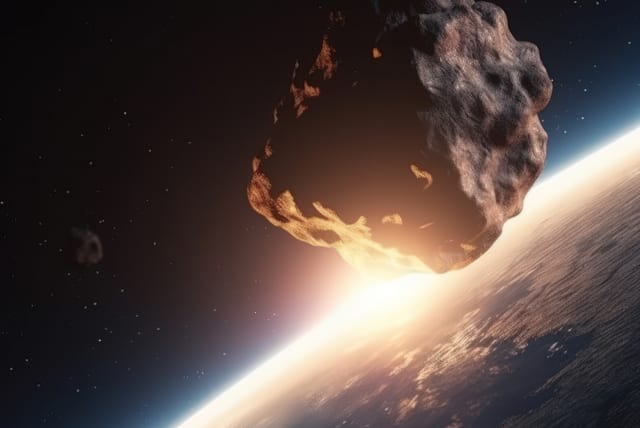Giant asteroid the size of 770 lions to pass Earth Thursday, June 27 - NASA

Using the ESA's measurement, asteroid (415029) 2011 UL21 is around the size of 770 adult male lions from head to tail.
A gigantic asteroid the size of around 770 lions is set to pass the Earth on Thursday. It is one of the largest of all near-Earth asteroids, according to NASA's asteroid tracker.
The asteroid in question has been designated (415029) 2011 UL21, according to the Center for Near-Earth Object Studies (CNEOS) at NASA's Jet Propulsion Laboratory (JPL).
According to the European Space Agency (ESA), (415029) 2011 UL21 is one of the single largest of all near-Earth asteroids (NEAs), and while it won't hit the Earth during its upcoming flyby, a potential impact scenario would arguably be the worst global catastrophe in millions of years.
Asteroid, have you forgotten me: How big is the asteroid set to pass Earth?
Asteroids come in a wide range of shapes and sizes, and when it comes to NEAs, we usually see them measured in terms of meters. But there is no underestimating just how big this one is. NASA JPL put its diameter between a more conservative 1.7 kilometers and the far more colossal 3.9 kilometers. The ESA averaged it out a bit more at 2.31 kilometers.
That's a lot of big numbers. But let us use a more relatable metric, something more down to Earth, something that everyone recognizes: Cats. Except housecats are too small for this, so instead, let's use their far bigger cousins: Lions.
According to the Smithsonian's National Zoo and Conservation Biology Institute, male lions grow to be around three meters long. So, using the ESA's measurement, asteroid (415029) 2011 UL21 is around the size of 770 adult male lions from head to tail.
But if this asteroid is so big, surely it must be flying slowly. But no, it's actually barreling through space at 25.88 kilometers per second. That means it would take less than five minutes for this asteroid to fly the distance between New York and London.
It's a big asteroid, and we ain't lion about it: How dangerous would this asteroid be if it hit the Earth?
Make no mistake: asteroid impacts can be devastating. Asteroid (415029) 2011 is officially designated a Potentially Hazardous Asteroid (PHA) due to its proximity to Earth and the sheer level of devastation it can cause.
To clarify, one of the criteria for designating a PHA is that it must have a diameter of at least 140 meters. Experts from the Davidson Institute of Science, part of Israel's Weizmann Institute of Science, say that an impact from an asteroid this large would be at least a thousand times more powerful than the first nuclear bomb dropped on Hiroshima.
Something even larger than that, such as over 300 meters, would have the force to destroy an entire continent.
An asteroid over a kilometer wide would be a worldwide cataclysm. And asteroid (415029) 2011 UL21 is over twice that size.
To put this in greater perspective, the last major asteroid impact on Earth was the Tunguska event in 1908, when what is believed to have been an asteroid impacted over remote Russia. The result was one of the largest known explosions to happen in recorded history, heard as far away as the US and Indonesia and was visible reportedly as far away as Scotland. It left a horrific level of devastation in its wake, even if only a few people were actually killed since it was so remote.
While experts disagree about the size of this asteroid, estimates range from as low as 50 meters wide to around 200 meters. Compared to asteroid (415029) 2011 UL21, that is a drop in the bucket.
Fortunately, we have nothing to worry about. All projections say the asteroid will fly over six million kilometers away from the Earth. On the cosmic scale, it's rather close, but it's over 17 times farther away than the Moon.
Hakuna ma-asteroid: Do we have no worries about a possible asteroid impact?
Asteroids have already hit the Earth this year and will do so again in the future. But these were minor impacts that left no damage.
Should a major impact happen, scientists in the field of planetary defense will be hard at work trying to find ways to stop it. This includes increasing surveillance to watch out for incoming space rocks, as well as means to try and neutralize the threat. The most promising method thus far was shown off in NASA's Double Asteroid Redirection Test (DART) Mission, which proved it could deflect an asteroid by slamming a spacecraft into it, nudging its orbital path ever so slightly.
But that doesn't mean we'd handle it well in practice. A recent simulated asteroid impact scenario by NASA and its partner organizations found major gaps in the global response system, even if we had 14 years to prepare.
In other words, while we made a lot of progress in planetary defense, humanity still has a ways to go to protect the Earth.
Jerusalem Post Store
`; document.getElementById("linkPremium").innerHTML = cont; var divWithLink = document.getElementById("premium-link"); if (divWithLink !== null && divWithLink !== 'undefined') { divWithLink.style.border = "solid 1px #cb0f3e"; divWithLink.style.textAlign = "center"; divWithLink.style.marginBottom = "15px"; divWithLink.style.marginTop = "15px"; divWithLink.style.width = "100%"; divWithLink.style.backgroundColor = "#122952"; divWithLink.style.color = "#ffffff"; divWithLink.style.lineHeight = "1.5"; } } (function (v, i) { });

